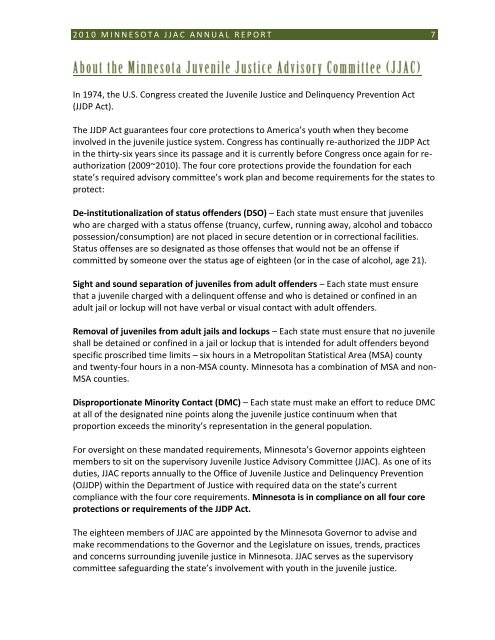Minnesota Juvenile Justice Advisory Committee - Minnesota State ...
Minnesota Juvenile Justice Advisory Committee - Minnesota State ...
Minnesota Juvenile Justice Advisory Committee - Minnesota State ...
You also want an ePaper? Increase the reach of your titles
YUMPU automatically turns print PDFs into web optimized ePapers that Google loves.
2 0 1 0 M I N N E S O T A J J A C A N N U A L R E P O R T 7<br />
In 1974, the U.S. Congress created the <strong>Juvenile</strong> <strong>Justice</strong> and Delinquency Prevention Act<br />
(JJDP Act).<br />
The JJDP Act guarantees four core protections to America’s youth when they become<br />
involved in the juvenile justice system. Congress has continually re-authorized the JJDP Act<br />
in the thirty-six years since its passage and it is currently before Congress once again for reauthorization<br />
(2009~2010). The four core protections provide the foundation for each<br />
state’s required advisory committee’s work plan and become requirements for the states to<br />
protect:<br />
De-institutionalization of status offenders (DSO) – Each state must ensure that juveniles<br />
who are charged with a status offense (truancy, curfew, running away, alcohol and tobacco<br />
possession/consumption) are not placed in secure detention or in correctional facilities.<br />
Status offenses are so designated as those offenses that would not be an offense if<br />
committed by someone over the status age of eighteen (or in the case of alcohol, age 21).<br />
Sight and sound separation of juveniles from adult offenders – Each state must ensure<br />
that a juvenile charged with a delinquent offense and who is detained or confined in an<br />
adult jail or lockup will not have verbal or visual contact with adult offenders.<br />
Removal of juveniles from adult jails and lockups – Each state must ensure that no juvenile<br />
shall be detained or confined in a jail or lockup that is intended for adult offenders beyond<br />
specific proscribed time limits – six hours in a Metropolitan Statistical Area (MSA) county<br />
and twenty-four hours in a non-MSA county. <strong>Minnesota</strong> has a combination of MSA and non-<br />
MSA counties.<br />
Disproportionate Minority Contact (DMC) – Each state must make an effort to reduce DMC<br />
at all of the designated nine points along the juvenile justice continuum when that<br />
proportion exceeds the minority’s representation in the general population.<br />
For oversight on these mandated requirements, <strong>Minnesota</strong>’s Governor appoints eighteen<br />
members to sit on the supervisory <strong>Juvenile</strong> <strong>Justice</strong> <strong>Advisory</strong> <strong>Committee</strong> (JJAC). As one of its<br />
duties, JJAC reports annually to the Office of <strong>Juvenile</strong> <strong>Justice</strong> and Delinquency Prevention<br />
(OJJDP) within the Department of <strong>Justice</strong> with required data on the state’s current<br />
compliance with the four core requirements. <strong>Minnesota</strong> is in compliance on all four core<br />
protections or requirements of the JJDP Act.<br />
The eighteen members of JJAC are appointed by the <strong>Minnesota</strong> Governor to advise and<br />
make recommendations to the Governor and the Legislature on issues, trends, practices<br />
and concerns surrounding juvenile justice in <strong>Minnesota</strong>. JJAC serves as the supervisory<br />
committee safeguarding the state’s involvement with youth in the juvenile justice.

















